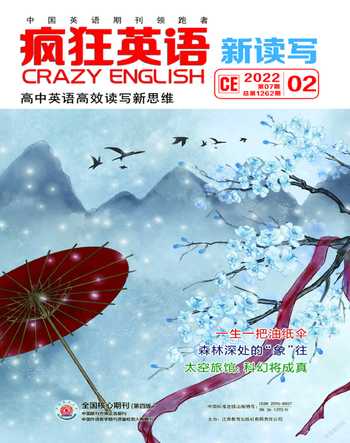一生一把油纸伞
蒋建平
20世纪60年代末,那时的李珍霞才5岁,她梦想着能拥有一把和奶奶家隔壁作坊里的一样好看的红色油纸伞。于是,小小年纪的她便有了一个大大的梦想……
In the late 1960s, when Li Zhenxia was 5, she dreamed of buying a beautiful, red oil paper umbrella in a store next to her grandmothers house. It was too expensive for her family to afford one at the time.
Today, Li is an entrepreneur (企业家) and an intangible cultural heritage inheritor(继承人), and she enjoys talking to her customers and passing on her techniques to her apprentices (学徒). “The oil paper umbrella is like my lover; it has been with me my whole life and always makes me feel better,” the 58?year?old said.
The traditional Chinese handicraft, which is made of bamboo and paper coated in the oil of the tung (桐树) nut for not letting water through, has been around for at least 1,000 years and was eventually adopted in other parts of Asia. Both ceremonial (用于礼仪的) and practical, it was used on rainy days, as well as during weddings and religious ceremonies. It is often found for sale at tourist sites or in hotels as decorations now.
Lis store in Datong Ancient Town in Chishui City, Guizhou Province—a town where there is a lot of rain—welcomes tourists who buy her umbrellas to model in photos, decorate their homes or add to collections, and sometimes even to use for catwalks at shows and performances. “Its more a piece of art that adds elegance (优雅) and grace than a means of protection from the rain,” she said.
Production involves over a hundred individual steps, from cutting the bamboo and threading the pieces together, to pasting on the paper shade, drying it in the sun and brushing it with oil. The whole process takes between 15 days and several months, depending on the umbrellas design, and this complexity means that its still made by hand.
One of her regulars, a 38?year?old woman surnamed Cai, has bought eight oil paper umbrellas from Li since 2016. She uses them on rainy and sunny days, matching them with her outfits. “It is a classic item with great cultural meaning. I dont use ordinary umbrellas anymore,” Cai said.
1. What does paragraph 3 mainly talk about?
A. Handicrafts in Asia.
B. The use of the tung nut.
C. The importance of traditional handicrafts.
D. Materials and functions of an oil paper umbrella.
2. Which word can best describe the production of an oil paper umbrella?
A. Complicated. B. Impossible. C. Simple. D. Interesting.
3. What does Cai think of oil paper umbrellas?
A. Theyre similar to ordinary umbrellas.
B. They can rarely match her outfits.
C. They have great cultural significance.
D. Theyre mainly used on rainy and sunny days.
Difficult sentence
The traditional Chinese handicraft, which is made of bamboo and paper coated in the oil of the tung nut for not letting water through, has been around for at least 1,000 years and was eventually adopted in other parts of Asia. 这种传统的中国手工艺品,由竹子和纸制成,涂有可防水的桐油,已经存在了至少1,000年,并最终被亚洲其他地区所采用。
【点石成金】本句为主从复合句,其中which引导的是一个非限制性定语从句,先行词为handicraft。

